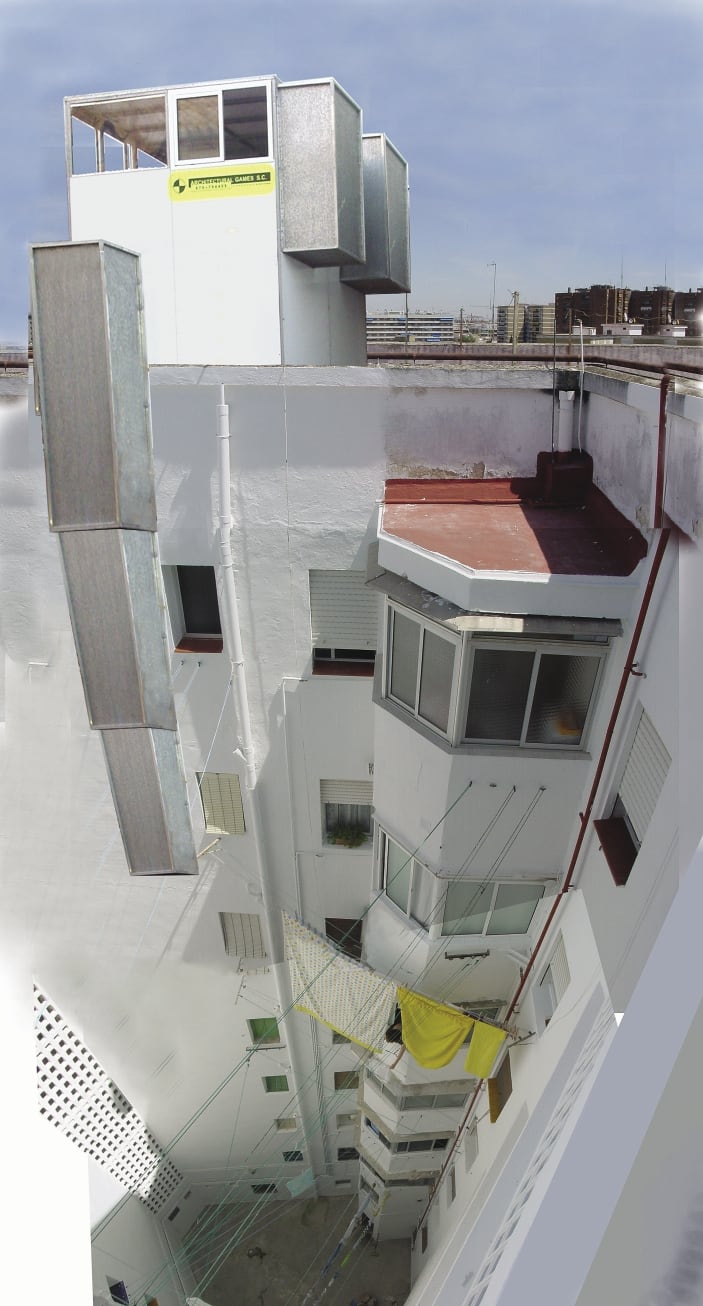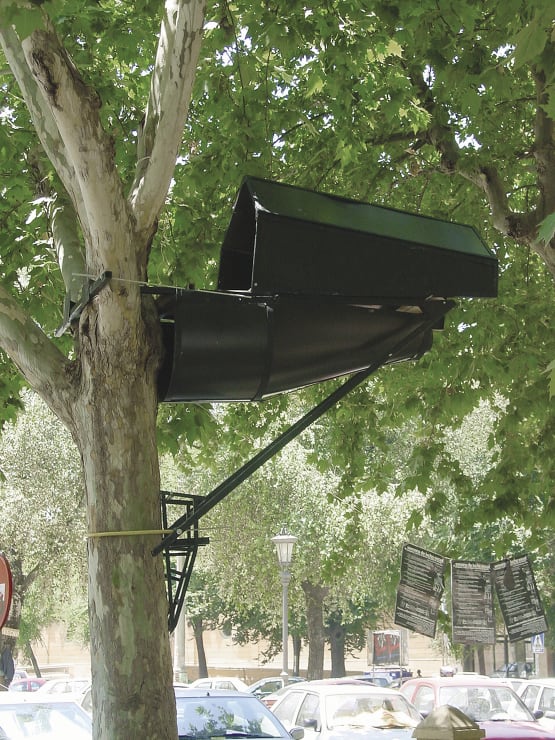
A dwelling is extracted from the fine print of planning and building codes. A modest architectural prosthesis, connected physically and psychically to four apartments. Here the architect rests, calibrates acts in which to reconfigure the city’s code.
In another location, across an ocean, a handful of portable structures stand, blue tarpaulins taut. A small village amongst trees.
Horizontal Property 2001 is a complex and innovative project by Spanish architect Santiago Cirugeda. In its two-fold brief, Cirugeda was to create a flexible space in which he could dwell, and continue a process of tackling legal structures, to think ‘around’ planning and building restrictions. Cirugeda has spent the past fourteen years (seven in solo practice, seven under the auspice of his studio Recetas Urbanas – Urban Prescriptions), negotiating the finest detail of planning and building codes to create an extensive body of socially experimental projects. The creative interpretation of existing legislation and the exploitation of its loopholes are, in essence, the modi operandi of his practice and, as such, are constantly recontextualised within his projects.
After establishing a legal basis for Horizontal Property, in which all phases of the project were justifiable relative to specific articles of the ‘Horizontal Property Act’1 and ‘Civil Code’, he made a remarkable negotiation with four tenants of a building wherein they permitted him to lease small portions of space from their respective apartments.2 Utilising this leased space and the building’s common light-well, he designed a series of irregular spaces which wove their way vertically through the existing interior of the building (the apartments being located over four floors) and were connected through circulation ducting, culminating in a ‘mobile element’ (an architectural kit) on the roof.3 In this complex spatial and legal arrangement, each apartment gave his new structure a common physical and legal foothold yet remained physically autonomous.
Cirugeda has also experimented with other prosthetic structures. In Scaffolding 1997 a permit was obtained to undertake work on the exterior of a building and a dwelling built within the confines of the scaffold. This new ‘temporary’ dwelling could be occupied legally for the duration of the permit which, according to Cirugeda, may be possible to extend indefinitely.
His oeuvre is diverse: roadside playgrounds, located in custom-made dumpsters (Skips S.C. 1997); temporary public spaces requisitioned from vacant lots (Temporary Occupation of Empty Lots 2004); prosthetic, temporary or permanent shelters (Insect House 2002 and Scaffolding); illegal and playful acts of subversion (Rigid Sheets 2005 and Illegal House for Pepe 2000); public housing developments/education centers (Civic Coexistence Preparation Project 2009) and projects for institutions (Institutional Prosthesis 2 (EACC) 2005). For a practicing architect, Cirugeda’s practice is about as unconventional as it gets. He collaborates almost exclusively — with students, activists, neighborhoods, collectives, associations and friends; participates in the physical construction of his own buildings; re-purposes materials (in AAABierta 2006, Recetas Urbanas salvaged an entire decommissioned building, taking it apart with students and used the materials to build a ‘center of operations’ in another location); and holds public discourse concerning his practice, including the disclosure of his occasional illegal activities and acts of civil disobedience. He makes technical and legal knowledge freely available through his ‘urban recipes’ (a ‘toolbox’ for direct architecture) and through physical projects (Bureau for Free Advice on Rooftops Alegal Houses 2004); participates in and instigates various forums for public discussion, including seminars, conferences, exhibitions and documentaries; and posits aspects of his practice as a ‘sporadic personal emancipation from urban control structures’.4
While the scope and scale of his practice has certainly expanded (commensurate with a burgeoning profile), the motivation and focus of Cirugeda’s practice remains unwavering. Cirugeda views architectural practice as social practice, intimately linked to social articulation and the expression of need, desire and dissatisfaction: ‘If we think about the city of the future, it’s really that city where the citizen recovers a bit of prominence’.5 Form extends then not as definitive statement, or even simply as formal experiment, but always as part of a perpetually evolving conversation, a complex social process, one of provisional consideration. Cirugeda is interested in the relevance of spatial practice on the social subject, intimately aware of the myriad social consequences of urban development (its intrusions and exclusions as well as its possibilities) and, as such, has established an unapologetically socially-oriented body of work. His practice, rooted in invitation, is essentially a practice of ‘participatory urbanism’.

While Cirugeda is predominantly concerned with new spatial articulations based along social lines — participation outside a professional elite — the Japanese architect and artist Kyohei Sakaguchi chronicles efforts of architectural and social self-reliance. Structures that, to some, may simply resemble the detritus from which they are constructed, appear to Sakaguchi as both poetic subjects — ‘This house makes good use of a reed screen. It shades the sunshine while still allowing a little light and a gentle wind into the house’ — and examples of an intimate architecture, the modest ambition of which (to shelter an occupant) brings the social, economic and ecological cost of housing into sharp relief.
Sakaguchi’s eye was drawn to an illegally built house on the banks of Tokyo’s Tama River in 2000 (in which its occupant had been residing for twenty years) partly by chance, but predominantly through intellectual empathy. He had been experimenting with modes of living in the city, as well as subjecting himself to certain material constraints. In Zero Yen Trip 1999 Sakaguchi hitchhiked throughout Japan and India with no money (although presumably there was an airfare involved). In the same year he lived in an unrenovated water tank for a week (Living in a Water Tank 1999). In 2001 he converted a discarded motorbike, a ‘Canopy’ by Honda, into a mobile house (The House Biker), and used the city’s restaurants, bookshops and coffee shops as personal amenities. As he put it, ‘the city looks like our house. I think I don’t need my real house. I ride on a house bike, and I use the facilities in Tokyo’.6
Architecture and Sakaguchi were never a good fit: ‘I had always wanted to design a house, but as soon as I began studying architecture, I realised that everyone there viewed homes as products and goods.’7 His taste was more intimate and social: ‘a house by nature, should be something free, flexible and personal.’8 Sakaguchi first began chronicling DIY structures in Tokyo House 2000, a 200-page handmade book, while studying architecture at Waseda University. This was followed by Road In 2002, in which he presented various street dwellings from Nagoya and Osaka. In 2004, he published the book Zero Yen House (literally ‘zero-dollar house’), which was significant in documenting and disseminating the building efforts of a resourceful minority of land-less urbanites to a wide audience.9
‘Zero Yen people’ are not homeless. They do not sleep under the shelter of a blanket, or a sheet of cardboard. They live in modestly scaled dwellings, yet possess no land (or the obligations of landowners). They set up compact, mostly collapsible dwellings on tracts of public or private space — along river banks, under bridges, on the fringes of disused or out of the way land. Any place they can find where they are nominally tolerated, with access to necessary resources such as water. If there is a need to relocate, their design makes this possible — one Zero Yen house is even poised on wheels for ‘speedy’ evacuation. Zero Yen people have essentially ‘opted out’. Their obligation is to feed, clothe and shelter themselves, a task they approach both unconventionally and resourcefully. To this end, money is earned (mostly from recycling), food gathered and grown, water collected from springs, possessions kept to a minimum and buildings made — often with particular attention to the specific needs of their respective inhabitants. While found and purchased materials are used for construction, the reuse of discarded materials predominates. Plastic tarps, ply-wood, twine, cloth, cardboard — anything salvageable is used. These piecemeal assemblages form something of an ‘idiosyncratic urban hut’: practical, intimate, a space of one’s own making.
Despite an evident regard for the practicality and simplicity of this lifestyle and the relative comfort most Zero Yen people attest to — kitchens, radios and TVs powered with discarded batteries or sometimes even solar panels — Sakaguchi is also conscious of not downplaying its trials, including the silent contempt reserved for societal ‘outsiders’ or, worse, the hostility and violence they are subjected to in the interest of maintaining the status quo through the enforcement of property rights.10 Cirugeda and Sakaguchi contextualise social circumstance as it is played out within the built environment. This contextualisation is an extant, non-speculative confrontation with the politics of the given moment, aligned to an empirical understanding of the street. From a willingness to engage ‘outside the office’ in the space of everyday life — ‘I want to be a citizen,’ says Cirugeda, ‘to understand what a city is, what a citizen is’11 — a practice and critique develop, and certain questions evolve.12 What is the future of the city? And, fundamentally, what is built, and on whose behalf is it built? For that which is not built, who suffers and how do they suffer in this neglect? Architects by rote of participation fulfill a role in the partitioning of space and, as such, in the flow of capital. Urban restructuring central to finance capital is unconcerned with other forms of social process, such as community determination. Diane Ghirardo in Out of Site 1991 argues that expenditure on projects of ‘bourgeois gratification’ (luxury houses, sky-scrapers, concert halls and museums) diverts funds from areas of specific need (social services, modestly priced housing), so that the urban fabric is altered not merely as byproduct, but through a ‘whole series of related actions issuing from a particular set of economic and social arrangements’.13 In a mercantile climate, as the market relegates social considerations to an afterthought, rentals soar and affordable housing becomes scarce.
Cirugeda seems continually to reiterate a suggestion, as practically as possible, that participatory urbanism — as complex social process — is a panacea for top-down style urban planning which tends only to represent that of the powerful minority. Cirugeda resists the idea that city dwellers are objects in what Gary Bridge describes as a ‘means-ends bureaucratic rationalization’14 and, after Henri Lefebvre, is engaged with the idea that there should be ‘freedom to create new kinds of urban spaces tailored to the needs of their inhabitants’.15 ‘My proposal’, he says, ‘consists of perpetually redefining global systems (urban planning and legislation), looking for possible loop-holes and uncertainties which allow the various human groups freedom of action.’16 The beauty of this thought, and his project, is to offer a means and model by which we may insinuate something of ourselves back into the cities in which we reside. The political agency of his project is broad and susceptible to inflection within the particularities of any new cultural context. In every sense, Cirugeda is as much social activist as architect or, more aptly, a fully socialised architect.
Sakaguchi, in an empirical exploration of how the city may accommodate ‘others’, chronicles a specific tale of self-determination. If, at times, he is prone to overstatement — he describes the Zero Yen house as the ‘primitive yet futuristic style of the ideal house’— his project remains relevant to a broad discourse on how the city may be negotiated now and into the future. A subtle, almost implicit, politicised thought continually resurfaces in his work: material ‘lightness’, equated with simplicity, reduces the physical impact of the urban dweller. When this is aligned to a nomadic disposition, as is evident within Cirugeda’s practice, we locate a means by which one may continually reiterate a claim to the city: to locate, via mobility, a little ‘elbow room’, or a means of thinking ‘on one’s feet’.
Jason Workman is a writer and artist.
